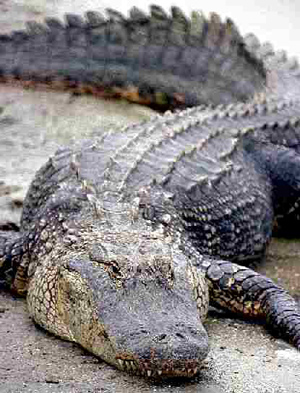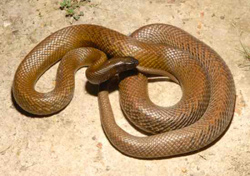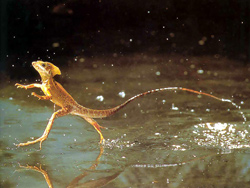 Reptiles have been around for 300 million years, even during the dinosaur age. Reptiles are a group of “cold-blooded” animals belonging to the class Reptilia. Cold-blooded means they can only control they body temperature by moving into cold places when hot, and warm places when cold.They breathe oxygen from the air and their skin is covered in scales or scutes. Although reptiles breathe through lungs, some reptiles can also absorb oxygen in water through membranes in their mouth. All reptiles, even the snakes, are tetrapods as they are four legged or have developed from four legged vertebrates. Reptiles can be found on all continents except for Antarctica. The science of reptiles is called herpetology. The most common reptiles include alligators, crocodiles, lizards, snakes, tortoises and turtles.
Reptiles have been around for 300 million years, even during the dinosaur age. Reptiles are a group of “cold-blooded” animals belonging to the class Reptilia. Cold-blooded means they can only control they body temperature by moving into cold places when hot, and warm places when cold.They breathe oxygen from the air and their skin is covered in scales or scutes. Although reptiles breathe through lungs, some reptiles can also absorb oxygen in water through membranes in their mouth. All reptiles, even the snakes, are tetrapods as they are four legged or have developed from four legged vertebrates. Reptiles can be found on all continents except for Antarctica. The science of reptiles is called herpetology. The most common reptiles include alligators, crocodiles, lizards, snakes, tortoises and turtles.
Interesting Reptile Facts
Reptiles are among the longest-lived species on the planet. For example, large tortoises such as the Aldabra tortoise can live for more than 150 years. Alligators can live nearly 70 years. Ball pythons, a popular type of pet snake, can live up to 40 years
It is a fact that more Americans die each year from bee stings than from snake bites.
The skulls of snakes are made up of many small bones that are interconnected in a flexible fashion. This is entirely different from a human skull, which is one solid piece. Most snake species can dislocate their jaw, allowing them to swallow prey much larger than themselves.. A common garter snake, for example, could swallow a frog more than twice the size of its head.
Reptiles, like birds, have voluntary control over the muscles in their eyes, which determine their pupil size. This means that they are able to constrict or dilate their pupils at will, not just in response to light.
The jaw structure of a reptile does not permit chewing; they can only tear their food.
Some reptile species are known to store sperm and produce young 3 years to 6 years after a single, successful mating.
The sex of a turtle is determined by the temperature at which the egg is incubated, with warmer temperatures producing females, cooler temperatures producing males and temperatures in the middle resulting in a mixed clutch. The situation is reversed for crocodiles, with males predominating at higher temperatures. The gender of a snake is determined by chromosomes, as it is in the case of mammals and birds.
There are more than 8000 reptile species in the world.
Reptiles do not have sweat or sebaceous glands; therefore, they are not slimy. So their skin is usually cool and dry. They are waterproof, and this, in addition to lacking a metamorphic stage is one of the distinctions between amphibians and reptiles (tadpoles metamorphose, or change, into frogs). Snakes have scales made up of keratin, which is the same material that constitutes our fingernails and hair. It makes their skin dry, cold and non-slimy.
The heaviest snake on record is an Anaconda (Eunectes murinus) that was shot in Brazil in 1960. She was never officially weighed but scientist estimate that her 27 feet 9 inch length and her 44 inch girth must have put her over 500lbs!
The king cobra is the longest venomous snake in the world. The longest specimen ever was kept at the London Zoo and measured 18 feet and 9 inches. Zookeepers killed it in 1939 due to the outbreak of war. They feared it would escape the zoo and pose a threat to the citizens of London.
The snake that is responsible for the most deaths of humans is the saw-scaled or carpet viper. It resides from West Africa to India.
 The worlds most venomous snake is PROBABLY the species of sea snake Hydrophis belcheri. It has a myotoxic venom that is 100 times more powerful than any land snake. The most venomous land snake is the Fierce Snake or Inland Taipan. The maximum yield recorded for one bite is 110mg, enough to kill about 100 humans, or 250,000 mice!
The worlds most venomous snake is PROBABLY the species of sea snake Hydrophis belcheri. It has a myotoxic venom that is 100 times more powerful than any land snake. The most venomous land snake is the Fierce Snake or Inland Taipan. The maximum yield recorded for one bite is 110mg, enough to kill about 100 humans, or 250,000 mice!
Most of the world's snakes (nearly two-thirds) are non-venomous. Only about 500 snake species are venomous, out of which only 30 to 40 harm humans. . In other words, less than 2 percent of all snakes are considered harmful to humans. The the opposite is true in Australia. There are actually more venomous snakes in Australia than non-venomous snakes. Australia is the only continent where venomous snakes outnumber non-venomous snakes.
There are more than 2,900 species of snakes in the world. They live almost everywhere, in deserts, forests, oceans, streams, and lakes. Snakes live on the ground, in trees, and in water.
Snakes are immune to their own poison.
Certain types of snakes can go months without eating. This is especially true of the big constrictors, such as the Anaconda and the reticulated python. Snakes eat large meals (relative to their body size), and they have much slower metabolisms and it takes time to digest it. .
Snakes cannot survive in places where the ground stays frozen year round so there are no snakes north of the Arctic Circle or in Antarctica. Some islands, including Ireland and New Zealand, do not have snakes at all.
If a snake is born with two heads, both its heads fight each other for food.
Snakes and lizards flick their tongues in the air to capture scent particles. They don't smell through noses, instead the use their tongues to collect scent particles and then pass the particles over something called a Jacobson's organ to decipher the air around them. This is partly how reptiles hunt for food.
The African egg-eating snake swallows eggs whole, and then use tiny "spikes" extending internally from its spine to crack the egg open and swallow the nutritious contents. Lastly, it will regurgitate the unneeded egg shell in a neatly folded piece.
It is believed that when a snake grows old, it sheds its skin. On the contrary, it is the younger ones who shed their skin since they grow faster.
The worlds fastest reptile (measured on land) is the spiny-tailed iguana of Costa Rica. It has been clocked at 21.7 mph!
The worlds largest lizard is the adult male komodo dragon found on the islands of Indonesia. The largest ever recorded was 10 feet 2 inches long and weighed 365 lbs! These lizards can eat animals as large as goats. They cannot chew so they must rip huge chunks of flesh off of their prey and swallow it whole.
The largest reptile is the , which grows up to 7 metres (23 feet) in length.
The smallest lizard in the world is the rare, tiny gecko of the Virgin Islands. Only 15 specimens have ever been found. They measure 0.70 inches from snout to vent (nose to butt).
Certain Chinese and American alligators can survive the winter by freezing their heads in ice, leaving their nose out to breath for months on end.
Of the approximately 200 eggs laid by a female leatherback sea turtle an average of two will survive their youth and grow to sexual maturity.
The tuatara lizard's metabolism is so slow they only have to breathe once an hour.
An iguana can stay under water for 28 minutes.
Most reptiles lay eggs which have leathery shells that are resistant to drying.
A majority of reptiles have a three-chambered heart.
A crocodile has an ability to grow new teeth to replace the old teeth.
The basilisk lizards can run across the surface of water without sinking.
The brain of a reptile is not more than 1% of its body mass. This means that the brain of a 70-pound python is no larger than a lima bean.
Most reptiles are carnivorous and eat insects, other reptiles and small animals.
A reptile will eat 30 - 50 times less food than do birds and mammals (warm-blooded animals) of a similar size.
Although reptiles cannot bear very cold climate, the Blanding’s turtle (Emydoidea Blandingii) can swim in ice lakes.
Sources:
http://www.stlzoo.org/animals/abouttheanimals/reptiles/tuatara/
http://en.wikipedia.org/wiki/Reptile
http://animals.nationalgeographic.com/animals/reptiles/green-basilisk-lizard/
http://www.reptileknowledge.com/
http://animals.nationalgeographic.com/animals/reptiles/
http://www.enr.gov.nt.ca/_live/pages/wpPages/Amphibians_and_Reptiles.aspx
http://www.junglewalk.com/info/crocodile-information.htm
http://www.sandiegozoo.org/animalbytes/a-reptiles.html
